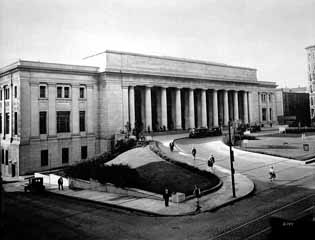Difference between revisions of "St. Paul Union Depot"
(table) |
m (Protected "St. Paul Union Depot" [edit=sysop:move=sysop]) |
||
| (2 intermediate revisions by one other user not shown) | |||
| Line 8: | Line 8: | ||
! | ! | ||
|- | |- | ||
| − | |[[Image:Uniondepot.jpg]] | + | |<div style="text-align: center;"> |
| − | | This brooding neoclassical structure served as St. Paul’s point of departure and entry for 50 years. It was a terminus of several interstate and local trains, and it was an important stop on the Empire Builder, which still runs from Chicago to Spokane, Washington. | + | [[Image:Uniondepot.jpg]] |
| − | + | </div> <div style="text-align: center;"> | |
| − | + | <small>'''St. Paul Union Depot shortly after it was built. Image courtesy of the Minnesota Historical Society.'''</small> | |
| − | + | </div> | |
| + | | This brooding neoclassical structure served as St. Paul’s point of departure and entry for 50 years. It was a terminus of several interstate and local trains, and it was an important stop on the Empire Builder, which still runs from Chicago to Spokane, Washington. | ||
| + | Construction began in 1917 and finished in 1923—in time for the station to serve Minnesota during the height of passenger rail travel in the United States. At the peak of passenger usage, Union Depot served 18 tracks. | ||
| + | |} | ||
As former Senator Larry Craig’s bathroom episode attests, ports, stations, and other interstate travel destinations remain immensely popular cruising sites in Minnesota. Trains brought men from all locations and walks of life to a concentrated structure for brief periods of time. The men—who were frequently on business trips away from their wives and families—likely met in the station’s public restrooms for completely anonymous activity. Out-of-towners especially took advantage of this, and probably had clandestine engagements with resting porters, or with poor locals who “prowled” the station in search of easy money. Of course, this activity is difficult to prove. | As former Senator Larry Craig’s bathroom episode attests, ports, stations, and other interstate travel destinations remain immensely popular cruising sites in Minnesota. Trains brought men from all locations and walks of life to a concentrated structure for brief periods of time. The men—who were frequently on business trips away from their wives and families—likely met in the station’s public restrooms for completely anonymous activity. Out-of-towners especially took advantage of this, and probably had clandestine engagements with resting porters, or with poor locals who “prowled” the station in search of easy money. Of course, this activity is difficult to prove. | ||
Latest revision as of 11:29, 1 May 2010
Between 4th St, Wacouta St., Sibley St., and the Mississippi River, St. Paul.
| St. Paul Union Depot shortly after it was built. Image courtesy of the Minnesota Historical Society. |
This brooding neoclassical structure served as St. Paul’s point of departure and entry for 50 years. It was a terminus of several interstate and local trains, and it was an important stop on the Empire Builder, which still runs from Chicago to Spokane, Washington.
|
As former Senator Larry Craig’s bathroom episode attests, ports, stations, and other interstate travel destinations remain immensely popular cruising sites in Minnesota. Trains brought men from all locations and walks of life to a concentrated structure for brief periods of time. The men—who were frequently on business trips away from their wives and families—likely met in the station’s public restrooms for completely anonymous activity. Out-of-towners especially took advantage of this, and probably had clandestine engagements with resting porters, or with poor locals who “prowled” the station in search of easy money. Of course, this activity is difficult to prove.
Minnesota’s train stations were the first sites of urban renewal, a government investment in the urban landscape. Their placement suggests a confluence of transportation, industrial, and commercial uses—this combination formed early queer places in the Twin Cities. St. Paul’s Union Depot and Minneapolis’ Great Northern and Milwaukee Road Depots created surrounding vice districts that were the ancestors of contemporary queer areas.
Airplane travel supplanted the railroads after WWII; the last train left Union Depot 26 years after the War ended. The demise of Twin Cities train stations marked a change in Minnesota’s queer life, when queer uses broke out of the downtown limits. Despite this trend, three bars remain in downtown St. Paul. Two of them, Rumours/Innuendo, operate across the street from the old station. Many expect that trains will once again arrive here in the near future--locomotives may once again shape queer life in downtown St. Paul.
This page is still under construction. --SVC
Part of Minneapolis/St. Paul, MN: 100 Queer Places in Minnesota History, (1860-1969), (1969-2010)
